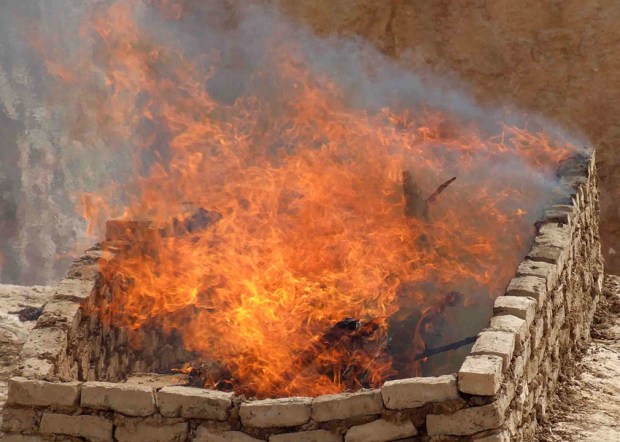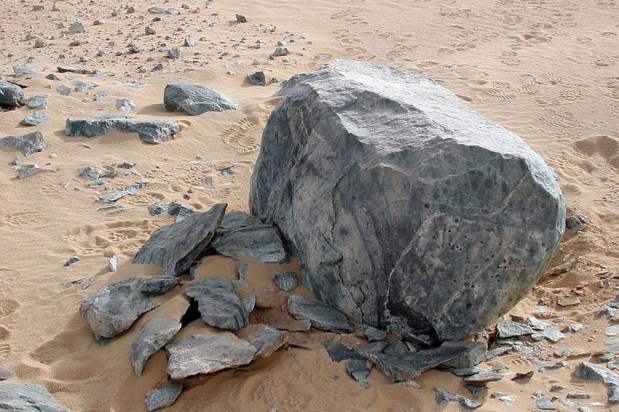It’s New Year’s Eve. Happy New Year to you all! What could be better than to end this little series on Ancient Egyptian quarries with firework! It was Reginald Engelbach that first suggested the use of fire for stone quarrying in Ancient Egypt, when he excavated the Unfinished Obelisk at Aswan almost a hundred years ago. Over the last decade much more evidence has been found in Aswan and elsewhere – and Adel Kelany and his team of archaeologists has even made experiments trying to figure out how firesetting works. Take a look at the following pictures to see how it looks like when old Egyptian stone has been subjected to fire!

Firesetting experiment at Aswan by Adel Kelany and his team in the Department for Ancient Quarries and Mines, Ministry of State for Antiquities. The subsequent removal of the softened granite by hammerstones was much easier than without fire. And the fire can be controlled in such a way that the rock intended for further working is not damaged. Photo: Adel Kelany

Old cracks in the granite at the Unfinished Obelisk quarry at Aswan. Such cracks were very probably induced by fire in the New Kingdom to ease the extraction of granite. Photo: Per Storemyr

Fire shattered rock surfaces at the silicified sandstone quarries by Gharb Aswan (West Aswan). Most likely a sign of an important stone extraction method in the New Kingdom. Photo: Per Storemyr

Shattered stone surfaces at Chephren’s quarry, Old Kingdom. Firesetting used to peel the block making it suitable for further work with hammerstones to create a sculpture. Photo: Per Storemyr
Thanks to all that have followed the little Ancient Egyptian quarry series on my blog – and to those who shared the stories on Facebook!
Here’s a summary of the series, with links to all the stories: Ten quarries of Ancient Egypt: Series summary








Hallo Per,
zu Deinem Bild “Fire shattered rock surfaces at the silicified sandstone quarries“
möchte ich etwas Anmerken:
1. Feuersetzen würde bei den Auswirkungen, wie sie auf dem Bild zu sehen, keinen Sinn machen, da lediglich Schutt und Scherben erzeugt würden, was man schon überall zur Verfügung hat und man es nur aufzusammeln braucht. Es wäre also reine Energie und Zeitverschwendung.
2. Um solche Schäden an silifiziertem Sandstein (Quarzit) zu bewirken würde auch kein noch so großes Feuer ausreichen. Man bräuchte dazu ein Raketentriebwerk, das tagelang den Stein erhitzen müsste!
3. Die Zerklüftungen, die weiten Risse und die Schalenbildungen sind rein tektonischer Herkunft.
Sie entstehen wenn größere Massen, oder wie hier eine langgestreckte Schicht/Bank relativ schnell abkühlen (Schwundrisse), und an den Bereichen, die während der Gebirgshebung stärkerer Verformung ausgesetzt sind. Also Rissbildung durch Biegung/Torsion an der schwächsten Stelle, wobei die Krafteinwirkung im Laufe der Zeit aus unterschiedlichen Richtungen einwirken kann.
Wie stark das Schwinden beim Abkühlen sein kann, zeigen die 6-Eck Säulen in Basaltsteinbrüchen, deren Durchmesser nur einige Dezimeter beträgt.
Kelanys Experiment war mehr eine Show, als ein Beweis. Das mürbe, desolate Oberflächengestein, das er mit enormem Aufwand befeuert hat, wäre auch ohne Erwärmung leicht abzuschlagen gewesen.
Ein realer Nachweis könnte nur an gesundem Kerngestein erfolgen, was er verschwiegen hat.
Feuersetzen ja, zum Beispiel beim Erzabbau mit anderen Parametern, aber nicht an massivem Hartgestein.
Viele Grüße
Wilhelm
Thanks for the response! But I certainly don’t agree.
First; your suggestion would have made sense if there were also other places in the area, outside of the quarries, with similar phenomena readily attributable to tectonic stress (or swift cooling, as you suggest). Such are not to be found at Gharb Aswan, mainly due to the lack of volcanic activity after deposition of the Nubian sandstone in this area, I would think. Silicification at Gharb Aswan, it has been suggsted (by the Klemms), took place by seeping waters from a lake or similar. But I have seen silicification of sandstone due to volcanic activity at many places in the sandstone regions of the Western Desert – and resulting great crack patterns due to rapid cooling (even extremely regular polygonal jointing just like in basalt).
Second; There are lots of similar crack-patterns as on the picture in the stone at Gharb Aswan – always, like in this case, followed by charcoal. But the stone was not used for sculpture, but for grinding stone (though there is also evidence of fire-setting related to all the sculptures produced at Gharb Aswan). Gharb Aswan is the largest grinding stone quarry from Ancient Egypt (covering an area of 50 square km). The evidence of fire setting to easily crack up suitable pieces for reduction by hammerstones is overwhelming.
Third; Adel Kelany’s experiment was not only a show. He could demonstrate that it was much easier to hack up the granite by hammerstones when it had been exposed to fire. But we have, of course, many other pieces of evidence for fire setting in these granite quarries. And in our interpretations, we e.g. rely on fire setting in granite quarries in India – taking place today.
Did you read our reports and papers on quarrying in the Aswan region? If not, have a further look at my website and my academia.edu page.
All best,
Per
Pingback: Fire on the rocks! New paper on firesetting in ancient Egyptian stone quarrying | Per Storemyr Archaeology & Conservation